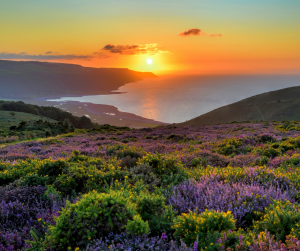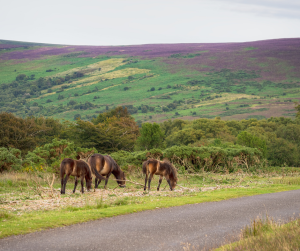Here, we share some of our favourite Exmoor facts to help you get to know the place a little better…
- It is named is after the River Exe, which has its source on the moors – in fact the national park is made up of picturesque valleys and meandering streams and rivers that flow through the rugged land to the sea
- Exmoor is teeming with flora and fauna, making it a great place to visit for those who love wildlife and celebrating the natural world. Exmoor is home to unique plants that don’t grow anywhere else, including various species of the whitebeam tree and a plethora of nationally rare plants, including lichens which have only been found on one specific Exmoor tree

- Exmoor serves as a vital habitat for one of Britain’s rarest butterflies, the heath fritillary butterfly
- The site acts as a sanctuary for England’s largest Red Deer population
- It is also home to the exceedingly rare Exmoor pony, a breed with historical significance dating back to the Domesday Book of 1086. These native ponies are free to roam the moors, with twenty different herds grazing across various commons. There is nothing more exciting than crossing paths with these lovely creatures during a walk or drive through the moors

- Exmoor boasts England’s highest cliffs. The highest cliff is named Great Hangman, with a spectacular 800ft cliff face looming over the roaring waves below.
- As well as having the highest cliff, Exmoor can also claim one of the most isolated stretches of coastline as the cliff’s extreme heights make the shoreline extremely remote.
- Once situated in the southern hemisphere, Exmoor’s geological formations now stand testament to millennia of continental drift, offering insight into the Earth’s dynamic history.

- Steeped in history, Exmoor boasts a wealth of archaeological sites, including prehistoric monuments and medieval structures, each telling a tale of bygone eras.
- Despite its geological significance, Exmoor remains sparsely populated, offering a serene retreat characterised by quaint villages and secluded cottages. Only 10,000 people live in the 692 km² National Park area across Somerset and Devon
- Countless writers and poets have been inspired by the stunning views and natural beauty found at Exmoor. Early Romantic poets William Wordsworth and Samuel Taylor Coleridge are among just some of the most notable examples. Calvert Exmoor itself has a connection to Wordsworth too as our name ‘Calvert’ comes from his friend Raisley Calvert, to whom he dedicated a poem to
- There is an Exmoor Beast. Eyewitnesses have described seeing a large, black cat-like creature roaming various locations, with the first sighting being reported in the 1970s. Since then, there have been numerous alleged sightings of the Beast despite no real concrete evidence that big cats are roaming the wilds of Exmoor – but black leopards are one of the attractions at Exmoor Zoo in North Devon.
To find out more about our site and the kinds of activities we offer, you can get in touch by calling 01598 763221 or emailing [email protected].

